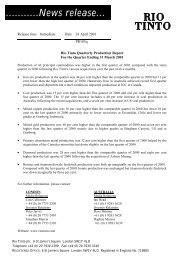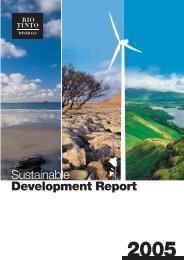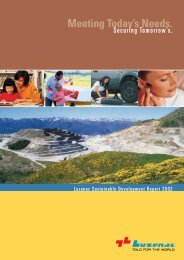Luzenac 20-pages - Rio Tinto
Luzenac 20-pages - Rio Tinto
Luzenac 20-pages - Rio Tinto
You also want an ePaper? Increase the reach of your titles
YUMPU automatically turns print PDFs into web optimized ePapers that Google loves.
mineral resources<br />
003<br />
16 <strong>Luzenac</strong><br />
argets vs performance<br />
> We extended Throw-Out technology to<br />
our Talc de <strong>Luzenac</strong> France plant.<br />
> We optimised our existing friction sorting<br />
system at our Yellowstone mine in<br />
the US and launched pilot studies in<br />
France and Australia.<br />
004 targets<br />
> Extend friction sorting pilot study to<br />
our Spanish operation, <strong>Luzenac</strong> SET.<br />
> Prepare long-term mining plans<br />
for all our North American mining<br />
operations.<br />
Making efficient use of our<br />
mineral deposits<br />
Sustainable development is often defined and discussed in terms of three<br />
‘pillars’ of performance—environmental, social and economical. We must<br />
bear in mind, however, that SD is principally about the wise management<br />
of resources. As the world’s leading supplier of talc products, <strong>Luzenac</strong> has<br />
a particular responsibility for the stewardship of its talc resources. It is our<br />
job to get the most ‘value’ (economical, social and environmental) from<br />
every tonne of rock we disturb and make the most thorough use of our talc<br />
ore bodies. The activities described below are just some examples of how we<br />
are doing this.<br />
Microwave technologies<br />
In collaboration with <strong>Rio</strong> <strong>Tinto</strong> Technical Services (RTTS) and its<br />
Office of the Chief Technologist, <strong>Luzenac</strong> is currently assessing<br />
innovative solutions to eliminate trace minerals responsible for<br />
major ore discolorations.<br />
These contaminants have a negative impact on recovery rates and<br />
in extreme cases significant fractions of the orebody have to be<br />
discarded. At our Trimouns mine in the French Pyrenees,<br />
for example, some of the brighter talc ore is irremediably<br />
contaminated by pyrites and there are minute graphite crystals<br />
throughout the orebody.<br />
Microwave technologies pioneered by a British university and<br />
RTTS look promising because they can selectively destroy the<br />
contaminant or enhance specific properties that can then be<br />
exploited for efficient separation.<br />
Throw Out<br />
Demand for white products is constantly growing. Yet, year after<br />
year, Talc de <strong>Luzenac</strong> France is forced to downgrade tonnes of<br />
white industrial minerals for simple process reasons.<br />
The purpose of the Throw Out project currently being led at our<br />
French operation is to meet this growing demand for white talc<br />
whilst respecting the natural balance of our mineral resources at<br />
Trimouns mine.<br />
Throw Out is a simple purification system enabling contaminants<br />
such as pyrites, carbonates and quartz contained in the mineral to<br />
be ejected during the pendular grinding process.<br />
optimise<br />
In <strong>20</strong>03, we completed the initial test phase on the five<br />
experimental Throw Out machines at our processing plant<br />
and are now entering the product qualification validation<br />
and industrial project phase.<br />
Our French mill will eventually house ten Throw Out<br />
machines linked to a centralised waste recovery system.<br />
Small Particle Sorter<br />
The Small Particle Sorter or SPS is a friction slide sorter<br />
system that separates talc from chlorite and other sterile<br />
products such as carbonates and pegmatites by friction<br />
sorting fractions of between <strong>20</strong>mm and 100mm.<br />
The process follows an initial screening process to obtain<br />
this fraction and which can, in some cases, lead to direct<br />
recovery of marketable grades (less than <strong>20</strong>mm).<br />
The combined screening-SPS process is used to recover<br />
marketable products from sterile sources, and purify<br />
certain industrial ores.<br />
SPS technology has been tried and tested by our North<br />
American operations and is currently undergoing pilot<br />
testing at our French and Australian operations.We are also<br />
looking to extend this technology to our Spanish operation,<br />
<strong>Luzenac</strong> SET. ¬


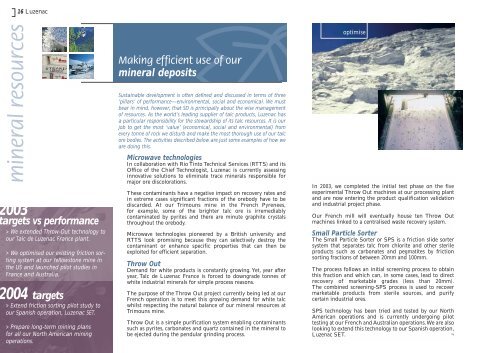
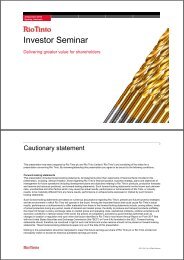


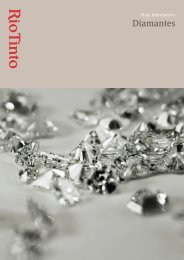

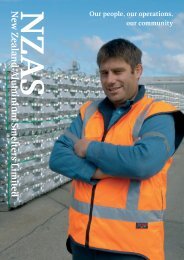
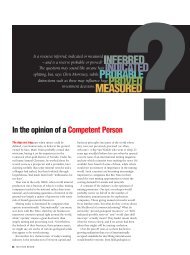
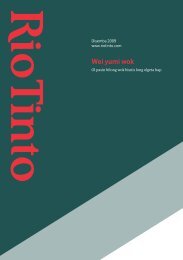

![Download pdf file [PDF: 1.26 MB] - Rio Tinto](https://img.yumpu.com/10319684/1/190x253/download-pdf-file-pdf-126-mb-rio-tinto.jpg?quality=85)

